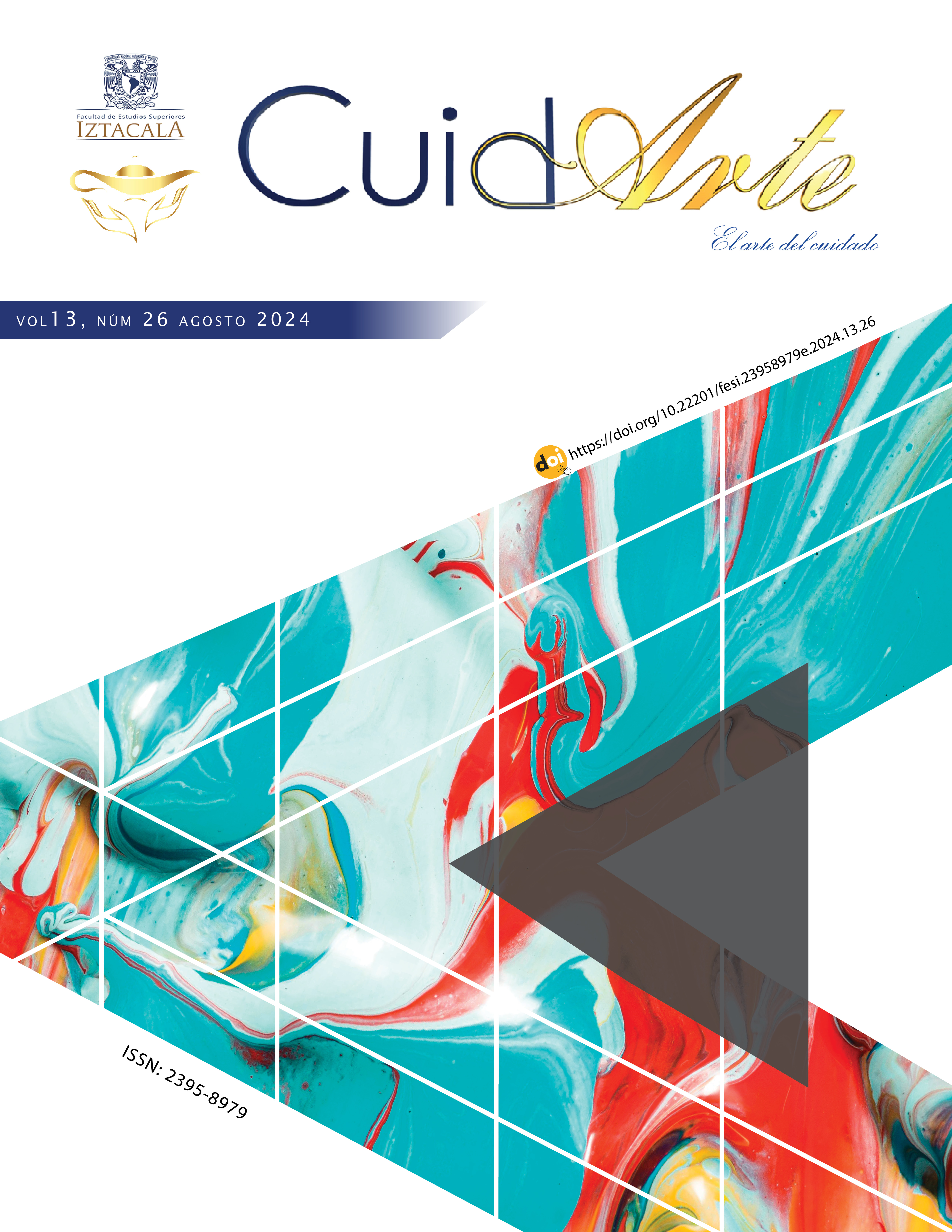Español
Main Article Content
Abstract
Introduction As people age, their quality of life is largely determined by their ability to maintain autonomy and independence. About 67% of people aged 60 years and older in Mexico have different chronic diseases, with the majority of COVID-19 deaths occurring in people aged 70 years and older, by COVID19 in 2020 and 2021.
Objective : To describe the situation of older adults with COVID19 intervened with telecare and home care for respiratory problems and comorbidities.
Methodology Quantitative study, of nursing intervention by convenience sampling and with the participation of a multidisciplinary team (nursing specialists, pulmonologists, nutritionist), as well as a longitudinal design of delivery of the intervention until the improvement of the participants was achieved.
Results or Findings: The predominant comorbidities in women more than in men were diabetes mellitus, arterial hypertension, diabetes and neurological problems as a consequence of COVID19. Almost half of the sample lived alone with their partner. Regarding housing, 2/3 of the patients have physical barriers, insalubrity or humidity or live on an upper floor. The main primary caregiver is the daughter (female) .
Conclusion: Home care and telecare are strategies that in parallel resolve the care in the face of an epidemiological health emergency, complications were reduced, hospitalizations were prevented, health problems in comorbidities were corrected and hospitalizations due to respiratory complications due to COVID19 were avoided.
Downloads
Article Details
Citas en Dimensions Service
References
(1). INEGI. Boletin. Encuesta Nacional sobre Salud y Envejecimiento en México (ENASEM) y Encuesta de Evaluación Cognitiva, 2021. 06 de julio de 2023. https://www.inegi.org.mx/app/saladeprensa/noticia.html?id=8294
(2). OPS, OMS. COVID-19 Consideraciones para el fortalecimiento del primer nivel de Atención en el manejo de la pandemia De COVID-19. 2021; https://iris.paho.org/bitstream/handle/10665.2/53112/OPSIMSHSSCOVID-19200035_spa.pdf?sequence=1&isAllowed=y.
(3). Plasencia UTM., y Aguilera RR, y Almaguer ML. Comorbilidades y gravedad clínica de la COVID-19: revisión sistemática y meta-análisis. Revista Habanera de Ciencias Médicas. 2020; vol. 19, no. 1:1-18. https://www.redalyc.org/articulo.oa?id=180465399002
(4). Porzio G, Cortellini A, Bruera E, Verna L, Ravoni G, Presi F, Spinelli G. Home Care for Cancer Patients During COVID-19 Pandemic: The Double Triage Protocol Journal of Pain and Symptom management. 2020; Vol. 60, Issue 1 July: e5 – e7-. https://doi.org/10.1016/j.jpainsymman.2020.03.021
(5). OMS. Atención en el domicilio a casos sospechosos o confirmados de COVID-19 y manejo de sus contactos. 2020; https://apps.who.int/iris/bitstream/handle/10665/333967/WHO-2019-nCoV-IPC-HomeCare-2020.4-spa.pdf
(6). OPS, OMS. COVID-19 Consideraciones para el fortalecimiento del primer nivel de Atención en el manejo de la pandemia De COVID-19. 2021; https://iris.paho.org/bitstream/handle/10665.2/53112/OPSIMSHSSCOVID-19200035_spa.pdf?sequence=1&isAllowed=y.
(7). Hunsbedt Fjellså HM, Husebø AML, Braut H, Mikkelsen A, Storm M. Older Adults’ Experiences With Participation and eHealth in Care Coordination: Qualitative Interview Study in a Primary Care Setting. J Particip Med 2023; 15:e47550. doi: 10.2196/47550
(8). Bernocchi P, Bonometti F, Serklini M, Assoni G, Zanardini M, Pasotti E, et al. Telehealth and Telecare: A Real-Life Integrated Experience in the COVID-19 Pandemic Telemedicine and e-Health. 2022; May 28:5: 720-727. https://doi.org/10.1089/tmj.2021.0181
(9). Kunz R, y Minder M. COVID-19 pandemic: palliative care for elderly and frail patients at home and in residential and nursing homes. 2020; Swiss Med Wkly; 150: No.1314. https://doi.org/10.4414/smw.2020.20235
(10). Edelman LS, McConnell SE, Kennerly MS, Alderden J, Horn DS, Yap LT. Mitigating the Effects of a Pandemic: Facilitating Improved Nursing Home Care Delivery Through Technology. Rev. Advancing Digital Health & Open Science. 2020; Vol 3, No 1. https://doi.org/10.2196/20110
(11). Steindal SA, Nes AAG, Godskesen TE, Holmen H, Winger A, Österlind J, Dihle A, Klarare A. Advantages and Challenges of Using Telehealth for Home-Based Palliative Care: Systematic Mixed Studies Review. J Med Internet Res. 2023 Mar 13;25:e43684. doi: 10.2196/43684
(12). Lyng, HB, Ree, E, Wibe T, Wiig, S. Healthcare leaders’ use of innovative solutions to ensure resilience in healthcare during the Covid-19 pandemic: a qualitative study in Norwegian nursing homes and home care services. 2021; 21:878 https://doi.org/10.1186/s12913-021-06923-1
(13). Cormi C, Chrusciel J, Laplanche D, Dramé M, Sanchez S. Telemedicine in nursing homes during the COVID-19 outbreak: A star is born (again). Geriatr Gerontol Int. 2020; Jun;20(6):646-647. https://doi.org/10.1111/ggi.13934
(14). Johannessen TB, Storm M, Holm AL. Safety for older adults using telecare: Perceptions of homecare professionals. Nurs Open. 2019; Jul 1;6(3):1254-1261. https://doi.org/10.1111/ggi.13934
(15). Glauser W. Proposed protocol to keep COVID-19 out of hospitals. CMAJ March 09, 2020; 192 (10) E264-E265; https://doi.org/10.1503/cmaj.1095852
(16). Kesavadev J, Basanth A, Krishnan G, Vitale R, Hari PH, Sajna S, et al. A new interventional home care model for COVID management: Virtual Covid IP. Diabetes & Metabolic Syndrome: Clinical Research & Reviews. 2021; Volume 15, Issue 5, Septembre – October.
(17). https://doi.org/10.1016/j.dsx.2021.102228.
(18). Secretaria de Salud. Gobierno de México. Dirección General de Calidad y Educación en Salud - Subsecretaría de Integración y Desarrollo del Sector Salud. Triage respiratorio en atención primaria. [Internet] Consultado en: http://www.calidad.salud.gob.mx/site/docs/triage_respiratorio_atencion_primaria.pdf
(19). Cruz AJ. El índice de Katz. Rev Esp Geriatr Gerontol 1991; 26: 338-48
(20). García GJV, Díaz PE, Salamea A, Cabrera D, Menéndez A, Fernández SA, et al. Evaluación de la fiabilidad y validez de una escala de valoración social en el anciano. Aten Primaria 1999; 23: 434-40.
(21). OMS. Uso racional del equipo de protección personal frente a la COVID-19 y aspectos que considerar en situaciones de escasez graves Orientaciones provisionales. 6 de abril 2020; https://apps.who.int/iris/bitstream/handle/10665/331810/WHO-2019-nCoV-IPC_PPE_use-2020.3-spa.pdf?sequence=1&isAllowed=y
(22). World Health Organization. Home care for patients with COVID-19 presenting with mild symptoms and management of their contacts: Interim guidance. 2020; Geneva: World Health Organization; https://apps.who.int/iris/bitstream/handle/10665/331473/WHO-nCov-IPC-HomeCare-2020.3-eng.pdf?sequence=1&isAllowed=y
(23). Coll BT, Palacio LJ, Añel RR, Gens BM, Jurado BJ, Perelló BA. Organización de la Atención Primaria en tiempos de pandemia [Primary care organization in pandemic times]. Aten Primaria. 2021; Dec;53 Suppl 1(Suppl 1):102209. Spanish. https://doi.org/10.1016/j.aprim.2021.102209
(24). Greenhalgh T. Covid-19: a remote assessment in primary care. BMJ. 2020; 368:m1182. https://doi.org/10.1136/bmj.m1182

